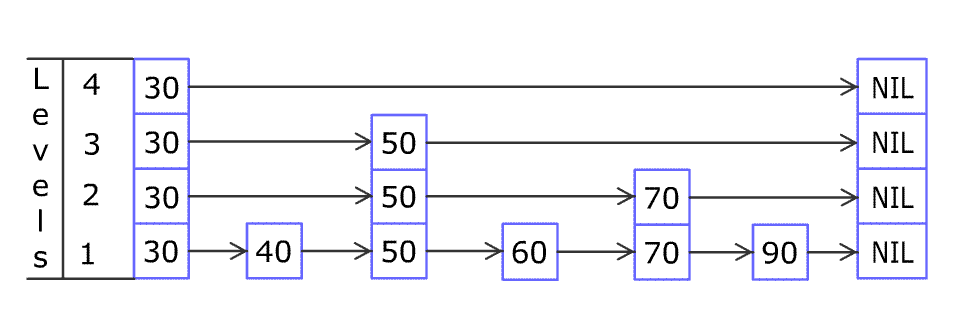 设计跳表Java
设计跳表Java
文章发布较早,内容可能过时,阅读注意甄别。
# 题目
不使用任何库函数,设计一个 跳表 。
跳表 是在 O(log(n)) 时间内完成增加、删除、搜索操作的数据结构。跳表相比于树堆与红黑树,其功能与性能相当,并且跳表的代码长度相较下更短,其设计思想与链表相似。
例如,一个跳表包含 [30, 40, 50, 60, 70, 90] ,然后增加 80、45 到跳表中,以下图的方式操作:
Artyom Kalinin [CC BY-SA 3.0], via Wikimedia Commons
跳表中有很多层,每一层是一个短的链表。在第一层的作用下,增加、删除和搜索操作的时间复杂度不超过 O(n)。跳表的每一个操作的平均时间复杂度是 O(log(n)),空间复杂度是 O(n)。
了解更多 : https://en.wikipedia.org/wiki/Skip_list
在本题中,你的设计应该要包含这些函数:
- bool search(int target) : 返回target是否存在于跳表中。
- void add(int num): 插入一个元素到跳表。
- bool erase(int num): 在跳表中删除一个值,如果 num 不存在,直接返回false. 如果存在多个 num ,删除其中任意一个即可。
- 注意,跳表中可能存在多个相同的值,你的代码需要处理这种情况。
示例 1:

- 输入
["Skiplist", "add", "add", "add", "search", "add", "search", "erase", "erase", "search"]
[[], [1], [2], [3], [0], [4], [1], [0], [1], [1]]
输出
[null, null, null, null, false, null, true, false, true, false]
- 解释
Skiplist skiplist = new Skiplist();
skiplist.add(1);
skiplist.add(2);
skiplist.add(3);
skiplist.search(0); // 返回 false
skiplist.add(4);
skiplist.search(1); // 返回 true
skiplist.erase(0); // 返回 false,0 不在跳表中
skiplist.erase(1); // 返回 true
skiplist.search(1); // 返回 false,1 已被擦除
提示:
- 0 <= num, target <= 2 * 104
- 调用search, add, erase操作次数不大于 5 * 104
# 思路
关键在于理解这种数据结构的思想
及随机层次的使用,避免变成线性链表
理解起来还是要花一些时间的,理解了写起来就容易多了
# 解法
class Skiplist {
final int maxLevel = 5;
Random random = new Random();
SkipNode head = new SkipNode(-1, maxLevel); //头节点
int level = 1; // 当前的层级,默认有一层
class SkipNode {
int val;
SkipNode[] forwards;
public SkipNode(int val, int level) {
this.val = val;
forwards = new SkipNode[level];
}
}
public boolean search(int target) {
SkipNode current = head;
for (int i = level -1; i >= 0; i--) {
while (current.forwards[i] != null && (current.forwards[i].val < target)) {
current = current.forwards[i];
}
}
return current.forwards[0] != null && current.forwards[0].val == target;
}
public boolean erase(int num) {
// 记录跳表中每一个层级的前序位置
SkipNode[] levelPres = new SkipNode[maxLevel];
SkipNode current = head;
for (int i = level -1; i >= 0; i--) {
while (current.forwards[i] != null && (current.forwards[i].val < num)) {
current = current.forwards[i];
}
levelPres[i] = current;
}
SkipNode removeData = levelPres[0].forwards[0];
if (removeData == null || removeData.val != num) {
return false;
}
for (int i = 0; i < level; i++) {
if (levelPres[i].forwards[i] != removeData) {
break;
}
levelPres[i].forwards[i] = removeData.forwards[i];
}
// 更新当前的 level
while (level > 1 && head.forwards[level - 1] == null) {
level--;
}
return true;
}
public void add(int num) {
// 记录跳表中每一个层级的前序位置
SkipNode[] levelPres = new SkipNode[maxLevel];
Arrays.fill(levelPres, head);
SkipNode current = head;
// 当前使用的层级 i 遍历每一层
for (int i = level -1 ; i >= 0 ; i--) {
// 遍历当前层级小于传入数据中最大的一个元素,即当前层级可以插入的位置的后面
while (current.forwards[i] !=null && current.forwards[i].val < num) {
current = current.forwards[i];
}
levelPres[i] = current;
}
// 当前数据需要落到第几层
int lv = randomLv();
// 当前最大的层级数需要更新一下
level = Math.max(lv, level);
SkipNode newNode = new SkipNode(num, lv);
for (int i = 0; i < lv; i++) {
newNode.forwards[i] = levelPres[i].forwards[i];
levelPres[i].forwards[i] = newNode;
}
}
private int randomLv() {
return random.nextInt(maxLevel) + 1;
}
}
/**
* Your Skiplist object will be instantiated and called as such:
* Skiplist obj = new Skiplist();
* boolean param_1 = obj.search(target);
* obj.add(num);
* boolean param_3 = obj.erase(num);
*/
1
2
3
4
5
6
7
8
9
10
11
12
13
14
15
16
17
18
19
20
21
22
23
24
25
26
27
28
29
30
31
32
33
34
35
36
37
38
39
40
41
42
43
44
45
46
47
48
49
50
51
52
53
54
55
56
57
58
59
60
61
62
63
64
65
66
67
68
69
70
71
72
73
74
75
76
77
78
79
80
81
82
83
84
85
86
87
88
89
90
91
92
93
94
95
96
97
2
3
4
5
6
7
8
9
10
11
12
13
14
15
16
17
18
19
20
21
22
23
24
25
26
27
28
29
30
31
32
33
34
35
36
37
38
39
40
41
42
43
44
45
46
47
48
49
50
51
52
53
54
55
56
57
58
59
60
61
62
63
64
65
66
67
68
69
70
71
72
73
74
75
76
77
78
79
80
81
82
83
84
85
86
87
88
89
90
91
92
93
94
95
96
97
# 总结
- 分析出几种情况,然后分别对各个情况实现


